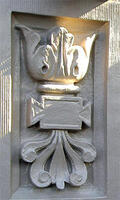HABITAT
Copying a Candela Cornice
June 22, 2009 — When he first got word that part of a terra cotta cornice had crashed to the sidewalk at 315 West 106th Street, David Brauner, president of that building's co-op board, flashed back to May 16, 1979. That's when a chunk of lintel infamously broke off from a building nearby, killing Barnard College freshman Grace Gold and setting into motion Local Law 11/98, mandating regular inspections of building façades.
"I did think back to that particular incident, both by virtue of our proximity to Barnard and my general familiarity," Brauner reflects. "My immediate reaction was, 'Thank God it was late and no one was on the street.'"
Then came the hard part: Deciding to remove, repair or replace the cornice. Because this wasn't just any cornice — this was a cornice on one of the first 16 or 17 buildings designed by one of New York's greatest architects, Rosario Candela, who would go on to fame in the late 1920s and 1930s for "a series of buildings that dominate the peak of apartment-house design in American history," wrote The New York Times architecture critic Christopher Gray, citing "elevated concepts of layout, amenities, spaciousness and luxury [that] set a new standard for the way rich people should live in multiple dwellings."
Even before the section of cornice fell in late 2006, the board was already searching for new property management "for all the usual reasons buildings switch managing agents," Brauner says. When Orsid Realty, the firm eventually chosen, came in, "a sidewalk bridge had already been erected and an investigation [had taken place] to ensure there wasn't additional danger at that point," says Pat Bettino, the successor manager. Otherwise, however, "Things had gotten bogged down. [The board had] been quoted something like a million two to do the work. We did it for about half-a-million."
That work, which would take place from June to October 2008, involved removing the cornice — the molded, horizontal crown that tops and juts out from the front of a building — and replacing it with a Fiberglas duplicate. The three choices the board had faced, says engineer Scott LaSala of Midtown Preservation, which did the work, were "to strip it from the building and replace it with brick; to replace the broken pieces with a precast stone embedded with a Fiberglas mesh" for strength and support; "or to just replace everything with Fiberglas."
Fiberglas: Not Just for Corvettes
"We had explored the possibility of replacing [the cornice] with terra cotta," says Brauner, "but we'd have had previous experience with Fiberglas since the building has decorative balconies that had become deteriorated 10 or 15 year ago, and we'd elected to use Fiberglas at that time. We never seriously considered stripping the cornice; we were aware of the architectural significance and the aesthetics of the cornice, and selected Fiberglas for its durability, its cost-effectiveness and its ability to replicate the look of the building" from 15 stories away.
work in progress
LaSala describes the physical process as first stabilizing the existing cornice and removing any additional loose pieces. He investigated the design and found it to be a repeating series of four terra cotta molds. "We dismantled part of the cornice and the contractor" — Tower Building Services, in Long Island City, Queens — "took it back to his shop and make molds out of them. They do it right at their shop. It took probably six to eight weeks before we started getting stuff back."
As for what happened to the original cornice stones, "I don't know," LaSala says. The typical fate of such architecturally significant detritus runs the gamut from winding up gracing the backyard of a friend of the contractor's to being sold to collectors or placed in museums.
Financed by Flip Tax
The co-op paid for the roughly half-million dollar job solely through its reserve fund, says Brauner, a real-estate attorney now with Windels Marx Lane & Mittendorf and board president for the last four years, following a stint as such for six years in the 1990s. "We have a flip tax that over the years has financed numerous capital improvement without the need for capital assessments. We enacted a flip tax in 1984, I believe; it was one of the first things I was involved in when I moved into the building" two years prior.





